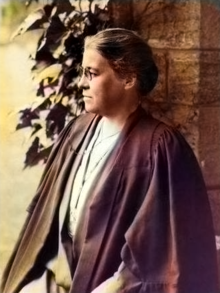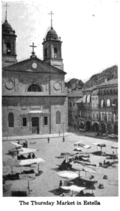Georgiana Goddard King
Georgiana Goddard King (born August 5, 1871 in Columbia , West Virginia , † May 4, 1939 in Hollywood ) was an American art historian and pioneer in the field of Hispanic studies .
biography
Georgiana Goddard King came from a wealthy family and was born in Columbia, a small town in West Virginia. Her father, Morris Ketchum King, was a railroad employee; the mother died when the daughter was ten years old. She grew up with her siblings with an aunt on her mother's side. Georgiana received an unusually good education for the time. She attended Leache-Wood Seminary , a boarding school for girls in Norfolk, founded in 1872 . After graduation, she studied at Bryn Mawr College for Women in the town of the same name in Pennsylvaniawhich had only opened in 1885 and was the first women's college at which degrees could be obtained. The head of the college, Martha Carey Thomas , attached great importance to the academic quality of the course, which is why she adopted the curricula and standards of the Johns Hopkins University in Baltimore , which in turn had made German universities its role model.
King graduated with a bachelor's degree in 1896 and won the George W. Child Essayist Award . She continued her studies in political science , German philosophy and English . In 1898 she spent a semester at the Collège de France in Paris , where her interest in art history aroused , also through her acquaintance with the art historian Bernard Berenson and his wife Maria. Through the Berensons she came into contact with art and architecture of the Renaissance , through her friends Gertrude and Leo Stein with modern European art. After returning to the United States, she taught in New York for seven years before returning to Bryn Mawr in 1906 to teach there.
In 1910, according to King's own account, she was tired of “explaining sentence structures to young women,” and she suggested that M. Carey Thomas offer courses in art history. Her lectures were so popular that in 1914 a separate Department of Art History was set up with King as professor. Against the advice of colleagues at Princeton and Harvard , she insisted on including Asian art in the curriculum. In the 1920s, a second professor was added with George Rowley. Towards the end of the decade, King invited the Austrian Josef Strzygowski to teach in Bryn Mawr , who was succeeded by Ernst Diez , also an Austrian.
It is not known why Georgiana Goddard King turned to Hispanic studies. The decisive factor could have been her friendship with the millionaire and Hispanic Archer Milton Huntington , who, through the Hispanic Society of America he founded, gave her the opportunity to travel to Spain more often at the Society's expense. She herself wrote in 1914 that she had a preference for the “rare and unknown”, which for “the dear readers” was more likely to apply to Spain than to Tuscany or Lombardy . The Spanish historian Ana Hernández Ferreirós wrote that King did indeed discover medieval Spanish architecture for the Americans. Her writings were less of an analytical nature, but rather aimed at the discovery of the unknown. The Society also sponsored the publication of the Bryn Mawr Notes and Monographs , which King had edited since 1921, with the proviso that half of the editions should be devoted to Hispanic subjects.
Her first publication on Spain was an annotated edition of George F. Street's 1865 book Some Account of Gothic Architecture in Spain , the first book in English on Spanish medieval architecture. King's comments were the result of three trips to Spain, "she was no armchair historian". By studying Street's book, she familiarized herself with historical methods and the associated field research and developed her own style through her varied training and interests.
King's next work The Way of Saint James (1920) was her own, partly personal text about the Camino de Santiago from Toulouse to Santiago de Compostela , in which she also brought her literary qualities and which she herself traveled in three sections in three different years . In it, she was the first historian to show how the pilgrimage stimulated art and cultural exchange, a design that other historians later adopted. She also focused on Spanish women and their role in society and reported on her own problems as a woman traveling alone in Spain. In the afternoon she was not able to stroll through the streets like the men, but had to retreat to her cold and dark hotel room with a hot water bottle until it was finally very late for dinner in Spain. She also reported an experience with a young Spanish guide on horseback. After three days, the man told her that a woman who was on her way was not worth much and that he was now “compromised” because he was accompanying her. She laughed and replied that at 42 she was old enough to be his mother - she couldn't compromise him and neither could he. In 1919 the Hispanic Society financed her and her friend Edith Lowber (1879–1934) another trip on which both women took photos of the Camino de Santiago. They then wrote the book Heart of Spain together , which was published in 1941 - after the deaths of both authors.
Georgiana Goddard King was a popular "own brand" professor. So she did not give grades and gave lectures in the dark so that the students could not take notes. Their enterprising and lively form of research had a strong impact on the young women, so that at least twelve of them would later follow their academic example and hold high-ranking positions at universities and museums. Those who studied with her did not state “art history” as their subject, but “with GG”. Since King liked to question the given roles of women and men with the words "I have done everything known to man", her students wrote a mocking song about them in the context of a well-known Christmas carol with a melody by the composer Felix Mendelssohn Bartholdy :
Hark the herald angels sing,
Here`s to Georgiana Goddard King .
Who is this who knows each thing
Yet she wears no wedding ring?
Peace on earth and mercy mild
Has she ever had a child?
.
Hear the messengers of angels sing,
Cheers to Georgiana Goddard King.
Who is she who knows everything even
though she doesn't wear a wedding ring?
Peace on Earth and Gentle Mercy
Has she ever had a child?
In the fall of 1935, King took a sabbatical and traveled to Portugal to do research for a book about Romanesque architecture there. She fell ill there and returned to the USA. Because of her poor health - she suffered multiple strokes - she was forced to retire, and she moved to live with her sister in Hollywood. Georgiana Goddard King died there in 1939 at the age of 67. At her request, she was buried in the cloister garden by Bryn Mawr ; the gravestone bears the inscription GGK .
Publications
- Georgiana Goddard King (Ed.): George Edmund Street; some account of Gothic architecture in Spain . 1914.
- Georgiana Goddard King (Ed.): George Edmund Street; unpublished notes and reprinted papers . The Hispanic Society of America, New York 1916.
- The Way of Saint James (= Hispanic notes & monographs ). Putnam's Sons, New York 1920 (3 volumes). Online: Volume 1 , Volume 2 , Volume 3
- Sardinian Painting - 1. The painters of the gold backgrounds (= Bryn Mawr notes and monographs . Volume 5 ). Longmans, Green and Co., New York 1923.
- Pre-Romanesque Churches of Spain (= Bryn Mawr notes and monographs . Volume 7 ). Longmans, Green and Co., New York 1924.
- Mudéjar (= Bryn Mawr notes and monographs . Volume 8 ). Longmans, Green and Co., New York 1927.
- Agnes Mongan (Ed.): Heart of Spain . Harvard University Press, Cambridge, Mass. 1941.
literature
- Janice Mann : "Hark the Herald Angels Sing". Here's to Georgiana Goddard King (1871-1939) . In: Jane Chance (ed.): Women Medievalists and the Academy . University of Wisconsin Press, Madison, WI 2005, ISBN 0-299-20750-1 , pp. 111-125 .
Web links
- Literature by and about Georgiana Goddard King in the WorldCat bibliographic database
- King, Georgiana Goddard . Publications in the bibliographic database of the Regesta Imperii .
- Entry in the Dictionary of Art Historians
- Georgiana Goddard King papers, 1874-1939. In: dla.library.upenn.edu. Retrieved May 5, 2020 .
Individual evidence
- ↑ a b c d e King, Georgiana Goddard. In: arthistorians.info. January 2, 2019, accessed May 5, 2020 .
- ^ Georgiana Goddard King. In: ilisso.it. Retrieved May 6, 2020 (Italian).
- ^ Mann, "Hark the Herald Angels Sing," p. 112.
- ^ Mann, "Hark the Herald Angels Sing," pp. 112/113.
- ^ Mann, "Hark the Herald Angels Sing," p. 113.
- ^ Mann, "Hark the Herald Angels Sing" , pp. 113/14.
- ^ A b Ana Hernández Ferreirós: Georgiana Goddard King (1871-1939), Pionera de la Historia del Arte Medieval en Galicia. Retrieved May 6, 2020 (Spanish). (pdf)
- ^ Mann, "Hark the Herald Angels Sing" , pp. 114/15.
- ^ Mann, "Hark the Herald Angels Sing," p. 116.
- ^ Mann, "Hark the Herald Angels Sing," p. 119.
- ^ Mann, "Hark the Herald Angels Sing," p. 116.
- ^ Mann, "Hark the Herald Angels Sing," p. 120.
- ^ Mann, "Hark the Herald Angels Sing," pp. 119/20.
- ^ Mann, "Hark the Herald Angels Sing," pp. 120/21.
| personal data | |
|---|---|
| SURNAME | King, Georgiana Goddard |
| BRIEF DESCRIPTION | American Hispanic and art historian |
| BIRTH DATE | August 5, 1871 |
| PLACE OF BIRTH | Columbia , West Virginia |
| DATE OF DEATH | May 4, 1939 |
| PLACE OF DEATH | Hollywood |





